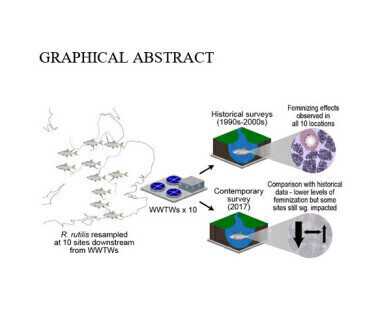Water/Wastewater
Persistent hormone distortion continues to affect fish populations
Aug 21 2023
Despite two decades of regulations and infrastructure upgrades, the issue of hormone distortion among fish populations in English rivers persists, raising concerns among scientists. While the exposure of wild roach to hormone-altering chemicals has reduced compared to two decades ago, the existing levels still raise alarms.
The phenomenon of endocrine disruption, which triggers male fish to develop female proteins and generate eggs in their testes, has been acknowledged since the 1980s. The treated sewage that enters rivers carries a mixture of chemicals linked to the female sex hormone, oestrogen, encompassing naturally occurring substances and those commonly found in everyday items such as plastics, shampoos, and sunscreens. As wild fish absorb these chemicals through their gills, they can develop a blend of both male and female biological traits, commonly referred to as being 'intersex.'
A recent study published in Environmental Science and Technology unveils that despite efforts to enhance sewage treatment facilities and impose stricter regulations, the concern of fish hormone disruption persists. Dr.Alice Baynes from Brunel University London emphasizes that while the severity of male fish displaying female characteristics has diminished in many revisited sites, the impact of endocrine-disrupting chemicals on wild fish downstream from wastewater treatment plants in England remains evident.
For the past four decades, researchers have been studying the roach, a resilient and small silvery fish prevalent in UK rivers and many parts of Europe. In the 1990s and early 2000s, ecotoxicologists examined over 50 locations along UK rivers, both upstream and downstream from wastewater treatment facilities, for signs of endocrine disruption in fish. Some of the most adversely affected fish were found in rivers near Leeds, where high levels of alkylphenols—detergents used in textile production—were concentrated. These alkylphenols are closely regulated by the EU's Water Framework Directive. The study also investigated the factors driving endocrine disruption, including naturally excreted oestrogens from both men and women, as well as pharmaceutical oestrogens used in contraceptives and hormone replacement therapy (HRT).
Although not mandated by regulations, many wastewater treatment plants have modernized over the past two decades. The Environment Agency commissioned the latest research to determine if endocrine disruption remains a concern. The recent study, conducted by a team from Brunel University London and the University of Exeter, revisited ten of the original river sites. Overall, wastewater treatment facilities now release fewer oestrogens into rivers. However, at 60% of the revisited sites, male roaches displayed intersex traits, with egg cells present in their testes. This irreversible alteration worsens with continuous exposure and negatively impacts breeding. Additionally, 90% of the sites showed male fish with elevated concentrations of female egg proteins, a sensitive indicator of estragon exposure, exceeding natural levels.
Various water treatment methods exhibit varying degrees of efficacy in removing oestrogens from wastewater. Processes like the activated sludge method, involving the infusion of oxygen into sewage tanks, are more efficient than methods like trickling filters, which involve passing sewage over stones. Incorporating tertiary treatments like sand filters and reed beds further enhance the removal process. A notable case is the Great Billing facility on the River Nene, which transitioned from trickling filters to the activated sludge process around 2001. This change correlated with fewer intersex roaches and reduced levels of female egg proteins in male fish. Among the rivers studied, the River Arun exhibited the highest prevalence of sex-reversed fish at 10.7%, where fish displayed entirely male or female genitalia but had the opposite genetic sex. In contrast, the River Lea and River Nene showed no instances of this phenomenon. Furthermore, the upstream section of the River Arun reported the highest count of intersex male fish at 40%. Other studied rivers included the Trent, Lea, Witham, Eye, Avon, Arun, and Bourne.
Dr. Baynes notes an intriguing shift in trends, mentioning that in the past, the extent of the issue was often linked to the size of the sewage treatment facility. However, recent findings indicate that some larger treatment plants, having received more investments and improvements, now exhibit better water quality compared to smaller facilities in towns and villages. This underlines the necessity for smaller sewage treatment plants to enhance their processes significantly to contribute to the health of river ecosystems.
Digital Edition
AET 28.2 April/May 2024
May 2024
Business News - Teledyne Marine expands with the acquisition of Valeport - Signal partners with gas analysis experts in Korea Air Monitoring - Continuous Fine Particulate Emission Monitor...
View all digital editions
Events
Jul 30 2024 Jakarta, Indonesia
China Energy Summit & Exhibition
Jul 31 2024 Beijing, China
2024 Beijing International Coal & Mining Exhibition
Aug 07 2024 Beijing, China
IWA World Water Congress & Exhibition
Aug 11 2024 Toronto, Canada
Aug 25 2024 Stockholm, Sweden and online









.jpg)








